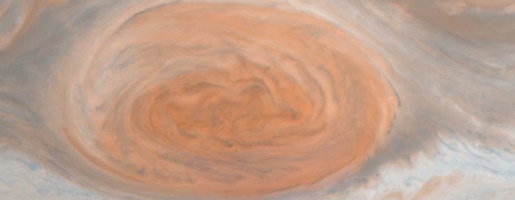 |
||||||||||||||||||||||||||||||||||||||||||||||||||||||||||
|
High
resolution image of the Great Red Spot, the Solar System's largest storm.
|
||||||||||||||||||||||||||||||||||||||||||||||||||||||||||
| THE ATMOSPHERE OF JUPITER | ||||||||||||||||||||||||||||||||||||||||||||||||||||||||||
| Jupiter lacks a solid surface like the rocky planets. It is not possible to land on Jupiter, as beneath the outer atmosphere are just progressively denser layers of gas which deeper within Jupiter are compressed into liquids. The parts we see and refer to as the "surface" are actually the uppermost visible layers of the atmosphere. | ||||||||||||||||||||||||||||||||||||||||||||||||||||||||||
| The largest planet also has the most complex atmospheric system known. Jupiter's size, brightness, and distinct colours means that even with a small telescope some detail can be seen of its exotic weather patterns. The atmosphere is highly mobile - rapid changes take place which are generally quite easy to observe from Earth. Not all surface features are generated by Earth's geological processes - the Earth has in the past suffered bombardment from space. Many other Solar System bodies have surfaces completely covered with impact craters, and our nearest neighbour, the Moon, is also heavily cratered. However, although much of the evidence of Earth's early bombardment has been obliterated, the surface still retains the scars | ||||||||||||||||||||||||||||||||||||||||||||||||||||||||||
| Belts, zones and colours | ||||||||||||||||||||||||||||||||||||||||||||||||||||||||||
| Jupiter has bands of varying shade and hue which are the result of differences in the chemical make-up of the atmosphere. Light orange and brown are the predominant colours, but there are paler pink tinged bands which are almost white. The darker bands are more intense shades of orange and brown. There are also bluish-grey patches and dark brown spots. The patterns which they make are complex and we are a long way from understanding Jupiter's weather. | ||||||||||||||||||||||||||||||||||||||||||||||||||||||||||
 The belts and zones of Jupiter as observed by the Hubble Space Telescope. |
||||||||||||||||||||||||||||||||||||||||||||||||||||||||||
| A system of naming for the bands or zones has been devised to enable the description of atmospheric features with respect to one another. Though it doesn't have as many belts as Jupiter, the same zone system is also used for Saturn. | ||||||||||||||||||||||||||||||||||||||||||||||||||||||||||
| As well as zones, the atmosphere of Jupiter is divided into two systems, Systems I and II. The rotation of Jupiter is influenced by its gaseous and liquid make-up, and its behaviour is very different to that of a solid body. The equatorial regions of the globe (9oN to 9oS), named System I, rotates faster than the northern and southern regions (System II) which lag by about 5 minutes. | ||||||||||||||||||||||||||||||||||||||||||||||||||||||||||
| When the Pioneer and Voyager spacecraft visited Jupiter they returned detailed images of its atmosphere. The Voyager images show particularly well the cloud forms, cyclonic and anticyclonic storms, swirls and eddy patterns. They show that parts of Jupiter's circulation system are turbulent and chaotic looking, while other flows are laminar or straight. As the Voyager spacecraft approached, images taken in succession were processed into time lapse sequences showing how gases flow, and give a true feel of the powerful weather on Jupiter. But while the clouds change locally in minutes and hours, larger scale patterns are quite stable for tens of years, or longer | ||||||||||||||||||||||||||||||||||||||||||||||||||||||||||
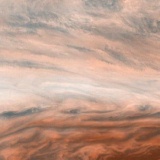 Turbulence at the equatorial region of Jupiter's atmosphere. |
||||||||||||||||||||||||||||||||||||||||||||||||||||||||||
| Zones of Jupiter's atmosphere | ||||||||||||||||||||||||||||||||||||||||||||||||||||||||||
|
||||||||||||||||||||||||||||||||||||||||||||||||||||||||||
| General circulation | ||||||||||||||||||||||||||||||||||||||||||||||||||||||||||
| Movement in Jupiter's atmosphere is often compared to the circulation of the Earth's. On Earth, cloud systems associated with high and low-pressure regions move around and can vary in latitude. The main difference between the planets is that on Jupiter the circulation cells and currents move around in belts. The relatively fast moving plume-like cells in the northern Equatorial Zone, as well as the turbulent flows which create complex ripple patterns, are confined to their respective latitudinal belts. | ||||||||||||||||||||||||||||||||||||||||||||||||||||||||||
| Large cyclonic phenomena, such as the Great Red Spot, move in longitude with respect to the rotation systems (I & II), but not in latitude. There are three white ovals found just south of the Great Red Spot. White spots like these occur nowhere else on the planet. The dark spots which are thought to be holes in the lighter orange-brown clouds, are found at latitudes near 18o N and nowhere else, while blue-grey splotches are seen only in the equatorial zone. | ||||||||||||||||||||||||||||||||||||||||||||||||||||||||||
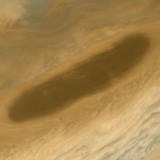 The Brown Barge, a dark feature thought to be a hole allowing lower depths to be seen. |
||||||||||||||||||||||||||||||||||||||||||||||||||||||||||
| One of the most studied bands of Jupiter is the South Tropical Zone (STropZ) which is centred at latitude 25o S and covers about 10o of latitude. The STropZ contains two circulating currents which flow along the edges of the zone. They move at about 200 kilometres per hour, the northern current flowing eastwards and the southern current flowing westwards. Spots evolving in the westward moving part encounter the Great Red Spot and are usually swallowed up in it. There is a famous case of a spot which did survive, attached to the edge of the spot and which moved around its edge. | ||||||||||||||||||||||||||||||||||||||||||||||||||||||||||
| Winds | ||||||||||||||||||||||||||||||||||||||||||||||||||||||||||
| Observations made by the Galileo probe show that winds on Jupiter are much stronger than first thought. Though observations from Earth show that they are not as powerful as the equatorial winds on Saturn or Neptune, wind velocities of more than 600 kilometres per hour have been recorded. | ||||||||||||||||||||||||||||||||||||||||||||||||||||||||||
| Deeper within the atmosphere, below the cloud deck encountered by the probe, winds were also quite strong. Solar heating may help to drive the surface winds, but strong winds at depth indicates that heat from within the planet is important in maintaining a system of convection. It is this convection system which helps the mobile gases to circulate about the planets upper layers. | ||||||||||||||||||||||||||||||||||||||||||||||||||||||||||
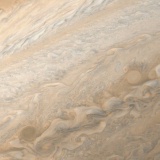 Voyager 2 image of the atmosphere at mid-latitudes showing evidence of turbulence and strong winds. |
||||||||||||||||||||||||||||||||||||||||||||||||||||||||||
| Lightning | ||||||||||||||||||||||||||||||||||||||||||||||||||||||||||
| The Galileo probe detected only a small amount of lightning. Researchers were expecting Jupiter's dynamic atmosphere to produce a great deal more. Galileo's instruments found that for a given area, there is less lightning on Jupiter than on Earth, about 10%. When lightning does occur though, it is about 10 times as powerful as lightning on Earth. | ||||||||||||||||||||||||||||||||||||||||||||||||||||||||||
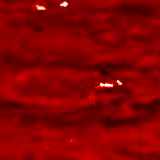 Flashes of lightning, amongst stormclouds lit by Io's moonlight. |
||||||||||||||||||||||||||||||||||||||||||||||||||||||||||
| Composition and chemistry | ||||||||||||||||||||||||||||||||||||||||||||||||||||||||||
| The clouds of Jupiter vary in colour from place to place depending on their chemical composition. They also vary with depth. Over most of the planet, the white clouds are the highest. These have a temperature of about 120 K. (-153oC) and pressure here is about 1 atmosphere (same as Earth at sea level). The white clouds are thought to comprise crystals of ammonia ice. As such, they are like the wispy cirrus clouds of water ice particles which form high in the Earth's atmosphere. | ||||||||||||||||||||||||||||||||||||||||||||||||||||||||||
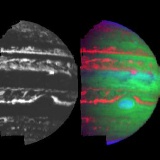 Different wavelengths allow different layers of Jupiter's atmosphere to be seen. |
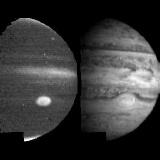 Altitude variation in Jupiter's clouds become apparent at different wavelengths. |
|||||||||||||||||||||||||||||||||||||||||||||||||||||||||
| The orange-brown clouds are at a level about 100 kilometres below the white clouds. They are seen all over the planet. The temperature of the atmosphere at the top of the orange-brown clouds is 200 K (-73oC ). These are composed of ammonium hydrosulphide which is a mixture of ammonia and hydrogen sulphide. There are other compounds of ammonia and sulphur in smaller quantities. It is the sulphur that gives the clouds their distinctive colour. | ||||||||||||||||||||||||||||||||||||||||||||||||||||||||||
| It is thought that below the brownish ammonium sulphide clouds there ought to be water ice and even droplets of liquid water. The temperature here is about 260 K (-13oC) and the pressure about five times the atmospheric pressure on Earth. Lower in Jupiter's atmosphere the temperature increases. This is because of the effect of Jupiter's internal heating and the greenhouse effect whereby long-wave infrared radiation is trapped by the atmosphere. A look at the temperature profile of the atmosphere shows that above the cloud layer, in a zone called the stratosphere, the temperature rises. This is called an inversion and is caused by gases and aerosol (finely dispersed liquid and particles) absorbing solar energy at this altitude. | ||||||||||||||||||||||||||||||||||||||||||||||||||||||||||
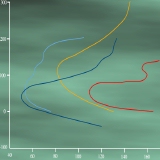 Temperature profile through Jupiter's upper atmosphere. |
||||||||||||||||||||||||||||||||||||||||||||||||||||||||||
| Recent observations made by the Galileo orbiter, the Galileo atmospheric probe and during the impact of the comet Shoemaker-Levy 9, have contributed further to our understanding of Jupiter's complex atmosphere. Even with such opportunities for study there are many unresolved issues regarding the composition of Jupiter. | ||||||||||||||||||||||||||||||||||||||||||||||||||||||||||
| The Galileo probe made its descent into a dark dry region where there are fewer clouds. Ammonia and hydrogen sulphide were found in greater quantities than expected, but virtually no water was encountered. It is thought that the region penetrated by the probe was a hotspot and not typical of Jupiter's atmosphere. The Voyager probe had suggested that water was present in greater quantities, while recent results show that the region which the probe entered contains less water than the Sun! | ||||||||||||||||||||||||||||||||||||||||||||||||||||||||||
 A dark, dry, hotspot in Jupiter's equatorial region. |
||||||||||||||||||||||||||||||||||||||||||||||||||||||||||
| With results from the Galileo Orbiter it is now more certain that on a global scale, the ratio of elements within Jupiter's atmosphere is a good match for amounts present in the Sun. Two elements, hydrogen and helium, make up the bulk (99%) of Jupiter's atmosphere. Scientists had expected a ratio of 15% helium to hydrogen. Measured using a helium abundance detector, the ratio was discovered to be about 24%. This matches the abundance expected of a planet forming from solar nebula material. | ||||||||||||||||||||||||||||||||||||||||||||||||||||||||||
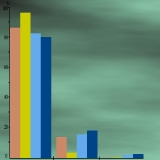 Atmospheric composition. |
 Atmospheric composition. |
|||||||||||||||||||||||||||||||||||||||||||||||||||||||||
| The abundance of helium (a very light element) ought to be counterbalanced by the presence of a greater quantity of heavier compounds. This was indeed shown to be the case. Higher than expected amounts of carbon, nitrogen, and sulphur were found in Jupiter's atmosphere. Fewer organic compounds were detected than anticipated. The amounts of heavier elements suggests that meteorite and cometary material have made an important contribution to Jupiter's mass, properties, and evolution. | ||||||||||||||||||||||||||||||||||||||||||||||||||||||||||
| Great Red Spot | ||||||||||||||||||||||||||||||||||||||||||||||||||||||||||
| Without doubt, Jupiter's most famous feature is the Great Red Spot. The Great Red Spot (GRS) is a giant, red-coloured, oval-shaped storm. Records indicate that it has been around for the past 300 years at least, and very probably longer than that. There are other spot phenomena including dark spots in the northern hemisphere and three large white spots in the south. Jupiter's Great Red Spot (GRS) is a huge oval-shaped storm, bigger than the Earth. In fact, two Earths would fit inside it. The long axis of the GRS is about 26,000 kilometres across and its short axis is 14,000 kilometres across. The spot occupies a feature known as the Red Spot Hollow which is a dark bay in the southern Tropical Zone (STropZ). | ||||||||||||||||||||||||||||||||||||||||||||||||||||||||||
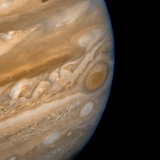 The Great Red Spot on the limb of Jupiter as seen by Voyager 1. |
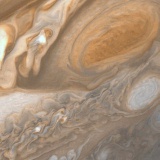 Voyager 1 image, from 5 million kilometres, of the Great Red Spot and a white oval. |
|||||||||||||||||||||||||||||||||||||||||||||||||||||||||
| Though it has been around for 300 years or more, from time to time it has disappeared. Such disappearances, recorded by earlier observers, were probably just a fading of the GRS' colour. The lack of contrast between the spot and its surroundings would give the impression that it had actually vanished. Each time it returned. | ||||||||||||||||||||||||||||||||||||||||||||||||||||||||||
| The earliest recorded observation of a feature fitting the description of the Great Red Spot was made by an English astronomer and mathematician, Dr Robert Hooke in 1664. More observations followed and accounts show that in 1665, just a year after Hooke's sighting, Cassini had seen the Great Red Spot. It was observed in the years after the discovery only occasionally, but since 1831 observations have been continuous. | ||||||||||||||||||||||||||||||||||||||||||||||||||||||||||
 High resolution image of the Great Red Spot, the Solar System's largest storm. |
||||||||||||||||||||||||||||||||||||||||||||||||||||||||||
| Records show that the intensity of the GRS's colour has changed. Periodically, the GRS undergoes a darkening, when it the reddish colour becomes deeper. Such episodes were recorded in 1879 and again in 1969 and 1975. Most of the time it is a reddish orange, but it has also faded to a lighter, dull orange, with some reports describing a greyish tinge to the Spot. | ||||||||||||||||||||||||||||||||||||||||||||||||||||||||||
| The more usual red colouration led naturally to an assumption that the region was hot, redness being associated with heat. This was later found not to be the case and that the GRS is red because of its chemistry. More recent theories of the nature of the GRS include the "floating raft" idea of the late 19th century. It was suggested that the spot floats like an egg in water. The GRS remains at a level where it is neither more dense than its surroundings and prone to sink, or less dense and prone to rise; in other words, it is neutrally buoyant. A popular theory in the 1960s was that the spot evolved over a rising column. Such a column, it was suggested, could be caused by a topographic obstacle at a boundary within the planet interfering with the flow of internal liquids. This idea too has fallen from favour because it doesn't fit with the observation that the GRS moves about longitudinally. The GRS is thought to go quite deep within the atmosphere. The spot also reaches higher in to the atmosphere than surrounding cloud deck, as indicated by lower temperatures than the surrounding area. These features are important because they enable a comparison with atmospheric phenomena on Earth. | ||||||||||||||||||||||||||||||||||||||||||||||||||||||||||
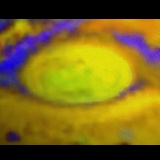 The Galileo spacecraft's near-infrared view reveals differing cloud heights - yellow / green is higher. |
||||||||||||||||||||||||||||||||||||||||||||||||||||||||||
| With Pioneer and Voyager it was possible to see detail in the GRS. But a thorough understanding of the GRS seems little closer. There are many outstanding questions. Why is there just one Great Red Spot? Why has it lasted so long? What caused it to begin with? How long will it last? | ||||||||||||||||||||||||||||||||||||||||||||||||||||||||||
| The only stable part of the phenomena is the oval shape, its position and colour vary. Observations made from Earth in the 1960s showed that the GRS rotates counterclockwise, making a complete circuit in 6 days, with outer-edge wind speeds reaching 400 kilometres per hour. The pattern resembles that seen in moving water on Earth. Water downstream of an obstacle in a river can move in a slow circular pattern called an eddy. The analogy seems to be a good one because the GRS appears quite steady and unchanged over a long period of time. Although turbulence is seen at boundaries, the flows and eddies seen in Jupiter's atmosphere are more stable and fluid than cyclonic behaviour on Earth. It is the combined effect of higher atmospheric density and temperature which causes Jupiter's surface to behave as a liquid. | ||||||||||||||||||||||||||||||||||||||||||||||||||||||||||
| White Ovals | ||||||||||||||||||||||||||||||||||||||||||||||||||||||||||
| There are long-lived white oval features, which rotate clockwise in the northern hemisphere and counter-clockwise in the southern. This is an attribute of high pressure centres. Three large white ovals south of the Great Red Spot have been observed for decades, and were named BC, FA, and DE. In 1998, BC and DE merged to form one oval - BE. Clouds within the ovals are higher than their surroundings. Between the northernmost two ovals was trapped a pear-shaped region of lower-level clouds. | ||||||||||||||||||||||||||||||||||||||||||||||||||||||||||
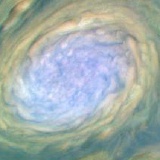 Galileo false-colour view shows the variations of cloud height that occur within a white oval. |
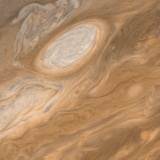 Voyager 2 image of white oval BC and surrounding turbulence from a distance of 3 million kilometres |
|||||||||||||||||||||||||||||||||||||||||||||||||||||||||
| Southern Belt Disturbances | ||||||||||||||||||||||||||||||||||||||||||||||||||||||||||
| The Great Red Spot isn't the only large whorl-like feature. Though it is the largest and most persistent storm on Jupiter, it is not unique. In 1900 several dark blotches were seen in the Southern Equatorial Belt (SEB) and Southern Tropical Zone (STZ), eventually these coalesced to form a band running through the entire STZ. The band came to be called the South Tropical Disturbance (STD). Where the band met up with the Great Red Spot it was accelerated past it. The STD begun to fade during the 1930s and the very last observation of the STD was made in 1940. | ||||||||||||||||||||||||||||||||||||||||||||||||||||||||||
| Disturbances in the South Equatorial Belt (SEB) have followed a similar pattern. They are not always dark though - sometimes they are light. First of all, spots appear. These spread out and intermingle, eventually forming a band. Over some periods they have occurred at intervals of three years: 1949, 1952, 1955, for example. Sometimes the disturbance has only returned after a longer absence but in a multiple of three: 1919, 1928, 1943. Other years there have been more than one event. In 1943 and 1971 there were two South Equatorial Belt disturbances. | ||||||||||||||||||||||||||||||||||||||||||||||||||||||||||
| When they first appear they can be located anywhere, located randomly along the belt. Their respective sources, however, are thought to be fixed deep within the atmosphere of Jupiter. They very probably originate at an unstable part of the interior where there is some temperature or density variation between the region and its surroundings. This bump or instability which begins as a small upwelling evolves into a twisting plume. Fed from below it rises quickly where it becomes incorporated into the rapidly circulating weather system, its longevity determined by its size and location. | ||||||||||||||||||||||||||||||||||||||||||||||||||||||||||
|
|
||||||||||||||||||||||||||||||||||||||||||||||||||||||||||